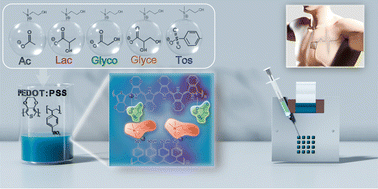Injectable PEDOT:PSS/cholinium ionic liquid mixed conducting materials for electrocardiogram recordings†
Abstract
Mixed conducting polymer electrodes built from poly(3,4-ethylenedioxythiophene):poly(styrene sulfonate) (PEDOT:PSS) are attracting a great deal of interest in healthcare monitoring. However, the widespread application of this organic conductor in wearable devices is seriously restricted by toxic additives used to enhance its electrical conductivity. Herein, we explored a family of biocompatible ionic liquids (ILs), based on the cholinium cation and different carboxylated anions, as dopants and gelators for PEDOT:PSS to formulate safe bioelectrodes for long-term cutaneous recording. We examined the effect of the IL anion on the ionic–electronic conductivities and physicochemical properties of these soft conductors. Among the different ILs tested, cholinium lactate ([Ch][Lac]) afforded the greatest increase in the materials’ electronic conductivity (≈30 S cm−1vs. 0.2 S cm−1 for non-formulated PEDOT:PSS). Moreover, the PEDOT:PSS/IL mixtures formed gels due to supramolecular intereactions. The gels showed a rheological behavior associated to gels with excellent injectability properties. Finally, the performance of PEDOT:PSS/[Ch][Lac] as biocompatible electrodes for electrocardiogram recording is discussed. All in all, the obtained results unveil the effectiveness of cholinum-based ILs as non-toxic dopants of PEDOT:PSS, paving the way to explore novel bioderived electrolytes.



 Please wait while we load your content...
Please wait while we load your content...